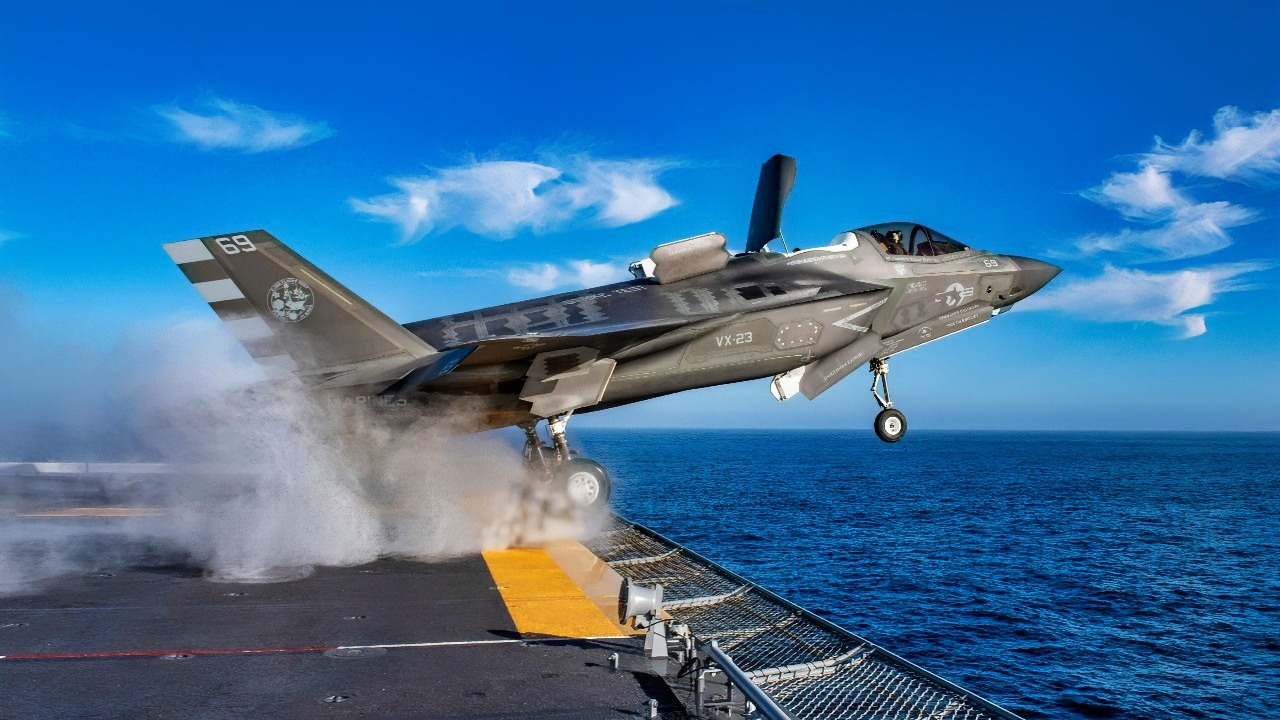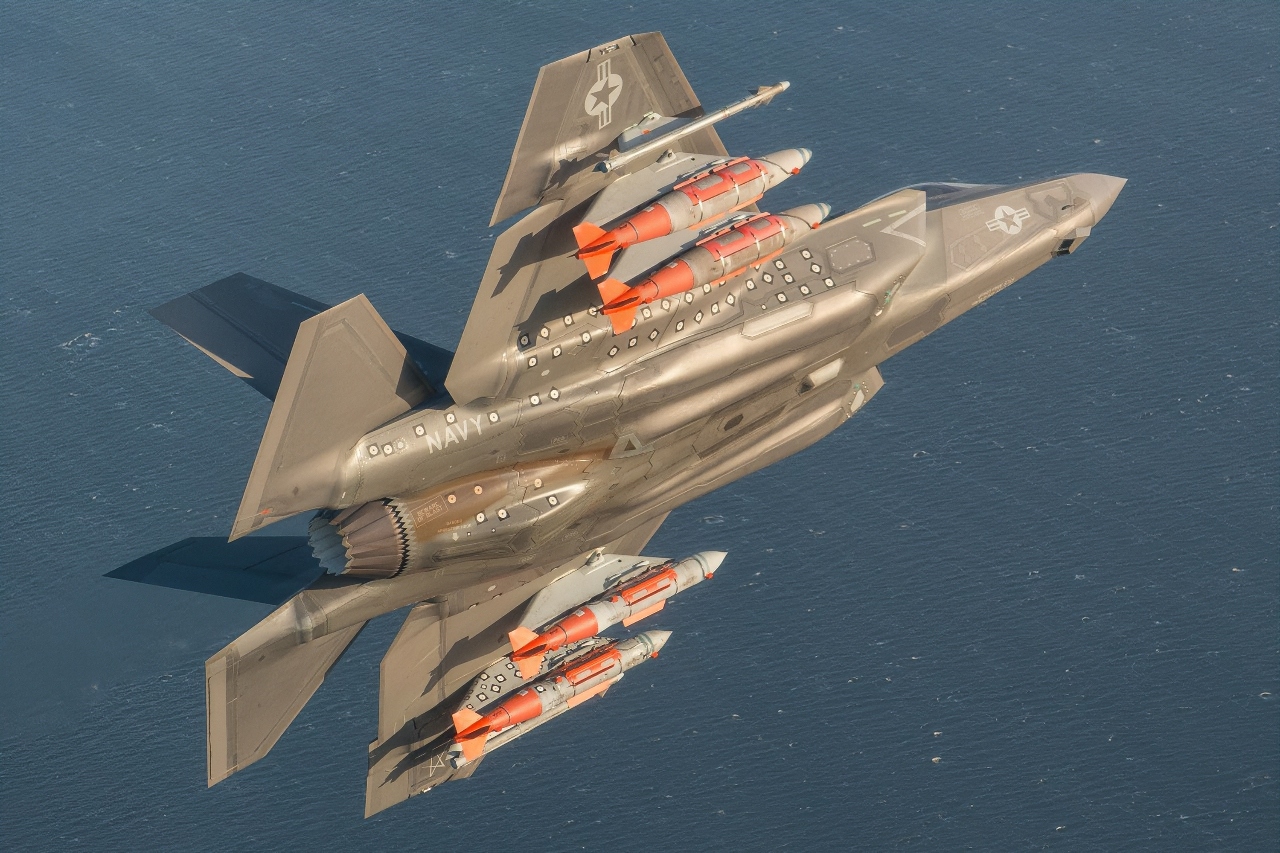Key Points and Summary – China has achieved a significant naval aviation milestone, releasing video of its J-35 stealth fighter launching via an electromagnetic catapult (EMALS) from the new aircraft carrier Fujian.
-This marks the first time any nation has publicly demonstrated an EMALS launch of a stealth fighter from a carrier at sea.

(July 28, 2017) An F/A-18F Super Hornet assigned to Air Test and Evaluation Squadron (VX) 23 approaches the aircraft carrier USS Gerald R. Ford (CVN 78) for an arrested landing. The aircraft carrier is underway conducting test and evaluation operations.(U.S. Navy photo by Erik Hildebrandt/Released).
-While the U.S. Navy’s USS Gerald R. Ford also has EMALS, it is not yet configured or certified to launch the F-35C. Experts explain this is due to the extensive integration required for the F-35’s complex maintenance and data systems (ODIN), which were not built into the Ford but will be included on the next carrier, the USS John F. Kennedy.
China’s New Aircraft Carrier Just Beat the U.S. Navy to a Major Milestone
Last month, China revealed what is considered an engineering breakthrough: An electromagnetic catapult system that makes it possible for a stealth aircraft to launch from an aircraft carrier.
According to Business Insider, the video footage was released by state media on September 21 by the People’s Liberation Army Navy (PLAN), which shows China’s “J-35 stealth fighter, J-15T carrier-based fighter, and KJ-600 early warning and control aircraft taking off from its Fujian carrier.”
Stars and Stripes reported that the state-run Xinhua News Agency and China Central Television also released the video. The videos were taken in early September, around the time of China’s Victory Day festivities.
The nearly nine-minute clip, per BI, consists of “crews readying warplanes for takeoff, the catapult launches, and aircraft recovery using arresting cables and tailhooks.”
This shows a development that could be very significant.
“It is remarkable how quickly China has moved from no carriers to older ski-jump designs, and now to electromagnetic catapults,” Matthew Funaiole, a senior fellow with the China Power Project at the Center for Strategic and International Studies, told BI after the video surfaced.

A joint team consisting of F-35 Patuxent River Integrated Test Force flight test members, U.S. Sailors and Marines, and the crew of the Japan Maritime Self-Defense Force Izumo-class multi-functional destroyer JS Kaga (DDH-184) are executing developmental sea trials in the eastern Pacific Ocean to gather the necessary data to certify F-35B Lightning II short takeoff and vertical landing aircraft operations. While aboard the MSDF’s largest ship, the Pax ITF flight test team has been gathering compatibility data for analysis in order to make recommendations for future F-35B operational envelopes, further enhancing the Japanese navy’s capabilities. The results of the testing will contribute to improved interoperability between Japan and the United States, strengthening the deterrence and response capabilities of the Japan-U.S. alliance and contributing to peace and stability in the Indo-Pacific region. Japan is an F-35 Joint Program Office foreign military sales customer planning to purchase 42 F-35Bs. The F-35 Joint Program Office continues to develop, produce, and sustain the F-35 Air System to fulfill its mandate to deliver a capable, available, and affordable air system with fifth-generation capabilities.
The View From China
According to a story in the China Academy, published in late September, senior Chinese military analyst Wang Qiang has touted the accomplishment.
Wang told the China Academy that “the electromagnetic catapult system on the Fujian employs a world-first medium-voltage direct current (MVDC) integrated power system, achieving a failure rate of less than 0.2%, just one-eighteenth that of the US Ford-class system. China’s Fujian, therefore, represents a significant milestone, overtaking the U.S. Navy in a core dimension of carrier aviation.”
The same report cites “two key innovations” in China’s approach: “it uses supercapacitors for energy storage, enabling full-system electrification” [and] “a parallel configuration: each catapult track has its own relatively independent power supply and energy storage module. If one catapult fails, it can be isolated in just 0.8 seconds without affecting the operation of the others.”
All About EMALS
The videos indicate that China has mastered electromagnetic launching technology, to do something—”launch a stealth fighter aircraft off of a carrier with an electromagnetic catapult for flight operations,” in BI’s words—that no other country, including the US, has thus far managed. “EMALS” stands for electromagnetic aircraft launch system.
According to previous reports from China, per BI, China test-launched a J-35 a year ago, without showing the takeoff itself. The report also said that the Fujian is heading into its final sea trials before commissioning.
“Clearly, China has won the race in terms of getting a fifth-generation [stealth fighter] to launch from an EMALS,” Sam Roggeveen, director of the International Security Program at the Australian think tank Lowy Institute, told Stars and Stripes.

J-35 Fighter Screenshot. Image Credit: YouTube Screenshot.
Lyle Goldstein, Asia program director for the Defense Priorities think tank in Washington, DC, told Stars and Stripes that the launch should be seen as a “significant set of developments in the evolution of China’s navy.”
Roggeveen added, however, that all is not lost when it comes to China’s recent advantages.
The country “simply doesn’t have the experience of operating and integrating an aircraft carrier with a broader military effort that crosses all the various services,” the Lowy Institute’s Roggeveen said in that interview.
“But they also have the advantage of being able to learn very quickly from the mistakes of others, particularly the United States.”
Can the U.S. Do That?
There’s only one U.S. carrier, the USS Gerald Ford, that is equipped with the EMALS system.
Per Stars and Stripes, the US “has not publicly disclosed a successful launch from the USS Gerald R. Ford,” although the story said that an F-35C test aircraft made an EMALS launch in 2011 from the Joint Base McGuire-Dix-Lakehurst in New Jersey.
According to the BI story, Gerald Ford has deployed with the electromagnetic catapult, but it has never used it to launch the F-35C, which is the carrier-based variant of the F-35.
“The ship is not configured or certified for that, though future vessels in the class are expected to be on delivery. The US Navy, however, has carriers available to deploy with combat-proven stealth fighters,” the BI story says.

Billie Flynn, F-35 Pax River ITF, conducts an external GBU-31 and AIM-9x buffet and flutter test flight (Flt 592) from Naval Air Station Patuxent River, Maryland, April 4, 2018, in an F-35C test aircraft, CF-2. Photo courtesy of Lockheed Martin.
BI added that there are “engineering hurdles” to using a catapult system to launch stealth aircraft from a carrier.
Another person with experience also weighed in this week.
What the F-35C Needs
According to Aviation Geek Club, an expert has weighed in on whether the U.S. can launch an F-35C from any Navy carrier.
JS Squidly, described as a former US Navy Senior Chief Petty Officer BMCS (SW/AW), answered questions this week on Quora, as reported by Aviation Geek Club.
“The F-35A/B/C all operate on a digital networked maintenance system. The system is called ODIN, aka Operational Data Integrated Network,” Squidly wrote on the social media site.
“However, ODIN is already the 3rd incarnation, acronym-wise… and there have been over a dozen major versions of all of them. ODIN is essentially a planning and diagnostic tool that shows maintainers exactly what to do with the jet. Planned, routine, preventative, corrective, and emergency maintenance all require this system to operate on the jet.”
Also, he added that squadrons that operate the F-35C in Carrier Air Wings aboard carriers “need hardware, software, and infrastructure on the flight deck, in the hangar bays, and in their maintainer work centers that can plug into ODIN.” In addition, he said that both the engines and the aircraft “need a special system.”
The network itself, meanwhile, “needs classified workstations including access to Top Secret data entry/access in SCIF.” Therefore, all of those things need to be built into the carriers themselves.
“For USS Ford, the ship was too far along in construction for the F-35 maintenance system to be included,” Squidly said on Quora. “USS John F. Kennedy will be up to the F-35C deployability standard at commissioning, as will the other forthcoming Ford-class ships under construction or planned.”
About the Author: Stephen Silver
Stephen Silver is an award-winning journalist, essayist, and film critic, and contributor to the Philadelphia Inquirer, the Jewish Telegraphic Agency, Broad Street Review, and Splice Today. The co-founder of the Philadelphia Film Critics Circle, Stephen lives in suburban Philadelphia with his wife and two sons. For over a decade, Stephen has authored thousands of articles that focus on politics, national security, technology, and the economy. Follow him on X (formerly Twitter) at @StephenSilver, and subscribe to his Substack newsletter.
More Military
Montana-Class: The U.S. Navy’s Superbattleships That Never Sailed
The F-35 Stealth Fighter Feels Like a Black Hole of Trouble
Russia’s Admiral Nakhimov Kirov-Class Battlecruiser Has a Warning for the Russian Navy
China’s Yuan-Class AIP Stealth Submarine Has A Warning for the U.S. Navy
Mach 6 SR-72 Darkstar Could Soon Be the ‘Fastest Plane on Earth’










